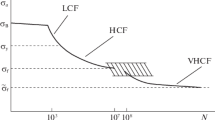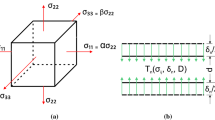Abstract
We propose a rule for the description of the accumulation of damage in materials under the conditions of cyclic straining. By using this rule, we study the processes of cyclic elastoplastic straining at the crack tip and deduce new kinetic equations of fatigue-crack propagation. It is established that the growth rate of a macrocrack in a cyclically deformed body depends not only on the parameters of loading and known strength characteristics of the material but also on the parameters taking into account the intensity of accumulation of defects and the instability of width of the hysteresis loop observed as the number of loading cycles increases.
Similar content being viewed by others
REFERENCES
J. Schijve, “Fatigue of structures and materials in the 20th century and the state of the art,” in: Proc. of the ECF14–2002, Vol. 3 (2002), pp. 211–262.
V. G. Troshchenko, Fatigue and Inelasticity of Metals [in Russian], Naukova Dumka, Kiev (1971).
L. E. Coffin, “A study of the effects of cycle thermal stresses in ductile metals,” Trans. ASME, No. 76, 794–807 (1954).
S. S. Manson, Thermal Stress and Low-Cycle Fatigue, McGraw-Hill, New York (1966).
V. V. Panasyuk, Limiting Equilibrium of Brittle Cracked Bodies [in Russian], Naukova Dumka, Kiev (1968).
J. R. Rice, “Mechanics of crack-tip deformation and extension by fatigue,” in: Fatigue Crack Propagations, (1967), p. 247.
B. Budiansky and J. W. Hutchinson, “Analysis of closure in fatigue crack growth,” Trans. ASME, No. 45, 267–276 (1978).
V. V. Panasyuk, O. E. Andreikiv, R. O. Ritchie, and O. I. Darchuk,” Int. J. Fract., 107, No. 2, 99–115 (2001).
N. A. Makhutov, Deformation Fracture Criteria and Strength Analysis of Structural Elements [in Russian], Mashinostroenie, Moscow (1981).
O. N. Romaniv, S. Ya. Yarema, G. N. Nikiforchin, et al., Fatigue and Cyclic Crack Resistance of Structural Materials [in Russian], Naukova Dumka, Kiev (1990), Vol. 4 in: V. V. Panasyuk (editor), Fracture Mechanics and Strength of Materials. A Handbook [in Russian], Naukova Dumka, Kiev (1988–1990).
A. Ya. Krasovskii and V. V. Kalaida, Strength and Crack Resistance of Spherulitic Cast Irons [in Russian], Naukova Dumka, Kiev (1989).
Author information
Authors and Affiliations
Rights and permissions
About this article
Cite this article
Panasyuk, V.V., Sylovanyuk, V.P. A Computational Model of Fatigue Fracture of Materials. Materials Science 39, 351–364 (2003). https://doi.org/10.1023/B:MASC.0000010740.79476.62
Issue Date:
DOI: https://doi.org/10.1023/B:MASC.0000010740.79476.62




